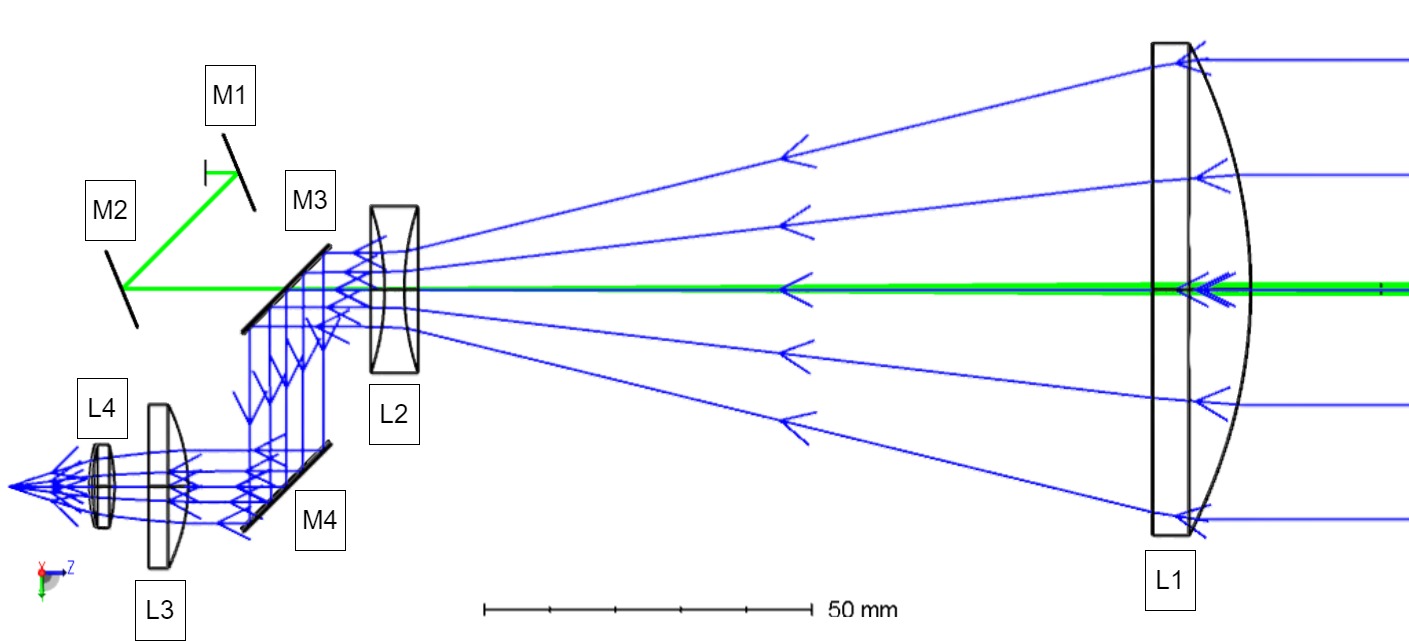Optical Design of a Miniaturized Laser Altimeter Implementing Single-Photon Counting Detection for Topographic Mapping using Small Satellites
- 1DLR Institute of Planetary Research, Berlin, Germany
- 2Faculty of Aerospace Engineering, Delft University of Technology, Delft, The Netherlands
Over recent decades, laser altimeters have been an essential tool in planetary exploration, enabling precise topographic characterisation of planetary bodies within the Solar System [1]. The working principle of this type of topographic measurement relies on a time-of-flight estimation of laser pulses emitted by the instrument and reflected from the surface of the target. A photon sensor then detects the returning signal, permitting the evaluation of the range between the satellite and the geological features, as well as the variations of intensity and spread of the beam shape. These strategies allow for the reconstruction of altitude, surface roughness, terrain slope, and albedo, thus enabling the creation of accurately calibrated digital maps of planetary landscapes [2].
The European Space Agency's BepiColombo mission to Mercury, as well as the JUICE mission to the Jovian system, carry the laser altimeters BELA (BepiColombo Laser Altimeter) and GALA (Ganymede Laser Altimeter). These instruments, developed by the DLR Institute for Planetary Research in collaboration with national and international partners, use the above-mentioned measurement approach but implement slightly different technical specifics. BELA will study the surface of Mercury from an orbit between 400 to 1000 km, using a 50 mJ Nd:YAG laser with a repetition rate of 10 Hz to cover a 6 to 40 m spot on the target [3]. Conversely, GALA will use 17 mJ pulses with a repetition rate of 30 Hz to determine topography on Ganymede from 500 km of altitude [4].
BELA and GALA have been implemented on large satellites and require significant volume, mass, and power resources. However, there is an increasing trend to employ small satellites and CubeSats not only in near-Earth orbit but also on interplanetary exploration missions [5]. Instruments must be miniaturised to enable laser altimetry for topographic purposes on such missions and open up new possibilities for innovative scientific investigations.
The goal of the current project is to pave the path for adapting the technology developed with BELA and GALA to the new scales being explored by small satellites and CubeSats. Indeed, the mass of the instruments (15 kg for BELA, 25 kg for GALA), their power consumption of about 50 W, and their receiver apertures of about 25 cm diameter [3,4] are not conducive to use on small satellite platforms. Here, we will report on the development of an elegant breadboard for a 3 CubeSat-Units laser altimeter implementing a transceiver design with an 8 cm aperture using Commercial Off-The-Shelf components (COTS) and a SPAD (Single Photon Avalanche Diode) array detector.
In our quest for the most suitable design, we conducted a trade-off study considering 16 possible optics arrangements. The focus was on a Lunar orbiter mission case, aiming to characterise future landing sites and assist in in-situ operations. The driving requirements for the selection were the compactness of the optical system, the laser footprint dimensions, the susceptibility to straylight, the coalignment budget, the transmittance, and the thermal stability. After a preliminary down selection and rigorous analyses of the last candidates in the optical design software Zemax, a final design was identified based on its performance in the above-mentioned requirements. The straight transmitter design combined with a double-deflective receiver performed best regarding internal stray light and coalignment budget, as shown in Fig. 1. This design can be accommodated in a 10x10x20 cm3 volume, equivalent to a 2U CubeSat design, leaving space for the implementation of the other subsystems of the instrument and demonstrating its practical application.
A laboratory setup implementing the design is currently being assembled (Fig. 2), and we will present a preliminary characterisation of the optics performance in terms of the quality of the laser expansion and the coalignment between the laser source and detector boresight axes. These studies will address the technology's readiness level and future development (adjustments) needed by the instrument, currently under Phase 0 study in collaboration with the European Space Agency.

Fig. 1: Zemax model of the final transceiver design. In green, the laser beam expanded by the transmitter optics; in blue, the received signal focused on the detector plane. The ‘L’ labels refer to the lenses, while the ‘M’ labels refer to the mirrors.

Fig 2: Detail from the transceiver design's CAD model showing the different components' arrangement. The ‘L’ labels refer to the lenses, while the ‘M’ labels refer to the mirrors. In green, the laser beam expanded by the transmitter optics; in blue, the received signal focused on the detector plane.
[1] Zhou et al., Infrared Physics & Technology 86, 147-158, 2017. [2] Kallenbach et al., Journal of Geodesy, 95:4, 2021. [3] Thomas et al., Space Science Reviews, 217, 25, 2021. [4] Hussmann et al, CEAS Space Journal 11, 381-390, 2019. [5] Michel et al., Planetary Science Journal, 3:160, 2022.
How to cite: Affatato, V., Althaus, C., Binger, J., Grott, M., Hussmann, H., Hüttig, C., Lingenauber, K., Potin, S., Saathof, R., and Stark, A.: Optical Design of a Miniaturized Laser Altimeter Implementing Single-Photon Counting Detection for Topographic Mapping using Small Satellites, Europlanet Science Congress 2024, Berlin, Germany, 8–13 Sep 2024, EPSC2024-474, https://doi.org/10.5194/epsc2024-474, 2024.